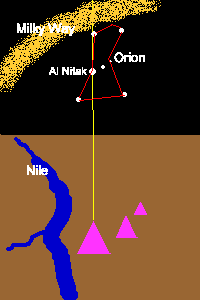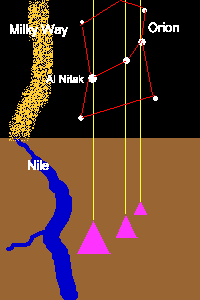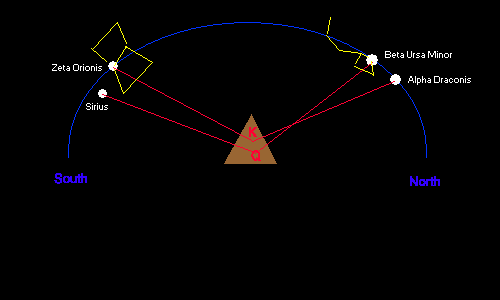Facts About The Egyptian Pyramids

The Great Pyramid And Pi.
 |
The Great Pyramid's designed height (481.3949 ft)
bears the same relationship to its base perimeter
(3023.16 ft) as does the circumference of any circle to
its radius, namely 2 Pi. Pi is not supposed to have been known until the Greeks discovered it in the 3rd century BC, yet the pyramids were built as long ago as 2,500 BC at least. |
The Great Pyramid - Earth Size Relationships.
 |
At the time of the ancient Egyptians
humanity was supposed to know nothing about the true size
and shape of the Earth. Is it therefore coincidence that
there is a relationship - in a scale of 1:43,200 - that
exists between the dimensions of the Great Pyramid and
the Earth? If you take the Pyramid's original height and multiply it by 43,200 you get a stunningly accurate estimate of the polar radius of the Earth. Pyramid's Height (481.3949 ft) x 43,200 = 3938.685 miles Which is an underestimate of only about 11 miles, as worked out by our best modern methods. Furthermore, if you take the Pyramid's perimeter and multiply it by 43,200 you get a very close estimate of the equatorial circumference of the Earth. Pyramid's Perimeter (3023.16 ft) x 43,200 = 24,734.94 miles Which is an underestimate of about 170 miles; an error of just three quarters of a percent. |
 |
The Great Pyramid - Alignment With The Stars.
| The Great Pyramid stands on a points on the Earth's
surface exactly one third of the way from the north pole
to the equator (30 degrees lattitude). Its north-south
alignment is true to within three sixteenths of a degree
- it is interesting to note that today's engineers could
only get the Meridian Building at Greenwich Observatory
in London aligned to an accuracy of nine sixteenths of a
degree. What about alignments with the stars? The Great Pyramid has a series of shafts within. Two of these shafts are aligned due north and the other two are aligned due south. Circa 2500 BC, each of these shafts targetted a special star as it culminated at the meridian (that is, when they were at their highest point above the horizon). |
|
| The north shaft from the King's Chamber (K) aligns
with the Pole Star, Thuban (Alpha Draconis) -
associated by the Pharaohs with 'cosmic pregnancy' or
'gestation'. The south shaft from the King's Chamber (K) aligns with Al Nitak (Zeta Orionis), the brightest and lowest of the stars in Orion's Belt. The ancient Egyptians associated this star with Osiris - their high god of ressurection and rebirth. The north shaft from the Queen's Chamber (Q) aligns with Kochab (Beta Ursa Minor) - a star the ancients associated with cosmic regeneration. The south shaft from the Queen's Chamber (Q) aligns with Sirius (Alpha Canis Major). This star was associated with the goddess Isis - the cosmic mother of the kings of Egypt. |
The Pyramids - More About Celestial Alignment.
 |
In 2500 BC (see left) the southern shaft of the
King's Chamber aligns perfectly with Al Nitak
(Zeta Orionis) at an altitude of 45 degrees. But at this
point in time the other two stars of Orions Belt and the
Milky Way do not align directly with the other two
pyramids and the Nile. If we 'shift' the sky around (see right), continually going back in time, we find a perfect match between the pyramids and the three stars of Orions Belt and the Nile and the Milky way at 10,500 BC ! |
 |
| As 2500 BC marks the zenith of Al Nitak (ie. when it is at its highest point above the horizon), 10,500 BC marks Al Nitak's nadir (ie, when it is at its lowest point above the horizon). Is this simply coincidence? |
Enter ... The Sphynx.
| The Spynx (about half a mile away from the pyramids)
points due east and in the pre-dawn of 10,500 BC
it would have pointed directly at its celestial
counterpart - the constellation of Leo. Therefore, at the moment of sunrise on the vernal equinox in 10,500 BC there would be a conjunction involving the three Pyramids and the Orion's Belt and a conjunction involving the Sphynx and the constellation of Leo. This conjunction marks the beginning of the 'Age of Leo' and the beginning of the upwards precessional cycle of Orion's Belt. |
 |
| Can all this be accidental? It seems unlikely that such engineering and astronomical precision can be purely coincidental. Either the Pharaohs had much more knowledge than we even thought remotely possible or, perhaps, a civilisation more ancient than the Egyptians (circa 10,500 BC, maybe?) once existed and was endowed with great knowledge. Either way, it seems that the epoch of 10,500 BC is being commemorated by the Pyramids and the Sphynx for some reason. |

